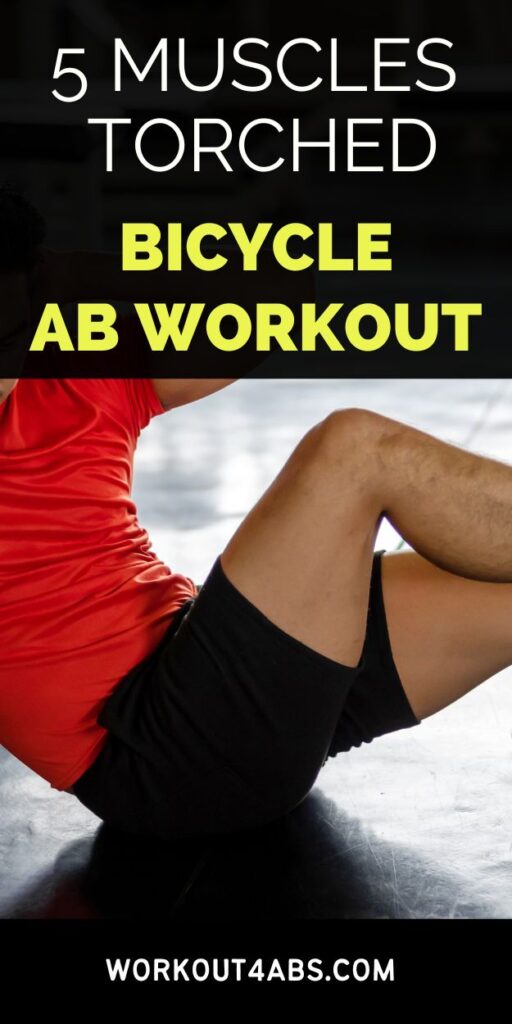Bicycle ab exercise explained! In this article you’ll learn about the targeted muscles – from the obliques to the rectus abdominis – highlighting how this dynamic move enhances core strength and flexibility. Learn the nuances of proper execution for optimal results and an effective ab workout.
Bicycle Ab Exercise Muscles Worked
The bicycle crunch, often referred to as the “bicycle ab exercise,” is a popular core exercise that primarily targets the muscles of the abdominal region. Specifically, it engages the following muscles:
- Rectus Abdominis: This is the most well-known abdominal muscle, commonly referred to as the “six-pack.” The bicycle crunch helps work the entire length of the rectus abdominis, as you contract and engage your core to lift your shoulders off the ground.
- Obliques: The external and internal obliques are muscles located on the sides of your abdomen. They play a significant role in twisting and rotating movements, such as the motion involved in the bicycle crunch.
- Transverse Abdominis: This deep muscle layer wraps around your abdomen like a corset, providing stability and support to your core. It is engaged to stabilize your trunk as you perform the twisting and pedaling motions of the bicycle crunch.
- Hip Flexors: While the primary focus of the bicycle crunch is on the abdominal muscles, the hip flexors, particularly the iliopsoas, are also involved in lifting your legs off the ground and bringing your knees toward your chest.
- Quadriceps: The front thigh muscles, or quadriceps, engage to some extent to help lift and hold your legs off the ground during the exercise.
It’s worth noting that the intensity of muscle engagement can vary depending on your form and execution. To maximize the effectiveness of the bicycle crunch, focus on maintaining proper form and controlled movements throughout the exercise.
Stop Doing Abs Like This! (SAVE A FRIEND)
How to Perform the Perfect Bicycle Crunch
To perform the bicycle crunch, start with 2–3 sets of 10–15 reps on each side. Adjust the sets and reps to ensure proper form throughout the exercise.
Here’s the step-by-step breakdown:
- Lie flat on an exercise mat, face up, with legs extended and feet on the floor. Raise your head and shoulders slightly off the mat.
- Place your hands at the back of your head, avoiding interlocking your fingers.
- Gently tuck your pelvis and lower your ribcage, engaging your core. Maintain a neutral spine and pelvis. Keep your chin tucked as if you’re holding an egg beneath it.
- Lift your knees toward your chest, bringing shins parallel to the floor.
- Activate your abs and lift the right side of your upper body off the floor, aiming your right elbow towards the left knee.
- Hold briefly at the end, squeezing your abs and obliques. Keep the left side of your upper body still and the right leg extended.
- Rotate the left side of your upper body, moving the left elbow towards the right knee. Simultaneously, lower the right side of your upper body and the left leg towards the floor.
- Continue alternating between sides for your chosen number of reps.
Remember to prioritize proper technique and controlled movements for the most effective bicycle crunch workout.
How to Do a Bicycle Crunch | Boot Camp Workout
Bicycle Crunch Main Advantage
The bicycle crunch offers several advantages that make it a popular choice among ab exercises. One of its main advantages is its ability to effectively engage multiple muscle groups and promote both core strength and flexibility. Here are some key advantages of the bicycle crunch over other ab exercises:
- Muscle Activation: The bicycle crunch targets not only the rectus abdominis (front of the abdomen) but also the obliques (side muscles) due to its twisting motion. This dual muscle engagement helps create a more comprehensive core workout.
- Oblique Development: The twisting movement involved in the bicycle crunch allows for effective targeting of the oblique muscles. These muscles are responsible for rotational movements and play a crucial role in activities that involve twisting or turning the torso.
- Functional Movement: The twisting motion of the bicycle crunch mimics real-life movements, such as reaching across your body or twisting to pick up objects. This can translate to improved functional strength and stability in daily activities.
- Cardiovascular Component: The bicycle crunch involves continuous and controlled movement, resembling a pedaling motion. This added dynamic element increases heart rate slightly, contributing to a minor cardiovascular workout alongside the core engagement.
- Flexibility and Coordination: Coordinating the movement of opposite elbow to knee while extending the opposite leg challenges your coordination and flexibility. This can enhance your overall body awareness and flexibility.
- Variety in Routine: Incorporating different ab exercises in your routine can help prevent workout plateaus and keep your routine engaging. The bicycle crunch adds variety and diversity to your core workout regimen.
- Minimal Equipment: The bicycle crunch requires minimal equipment – just an exercise mat or a comfortable surface. This makes it a convenient option for home workouts or when you don’t have access to a full gym.
- Scalability: The bicycle crunch can be modified to match various fitness levels. Beginners can start with basic movements and gradually increase intensity as they become more proficient.
It’s important to note that while the bicycle crunch offers these advantages, a well-rounded fitness routine should include a variety of exercises to target different aspects of core strength, stability, and overall fitness. Combining the bicycle crunch with other exercises like planks, leg raises, and static holds can create a comprehensive core workout routine.
If you enjoyed these tips for the bicycle ab exercise and would like to keep it close to you at any time, just save this pin to your Pinterest Board.

Home › Bodyweight Exercises ›Bicycle Ab Exercise